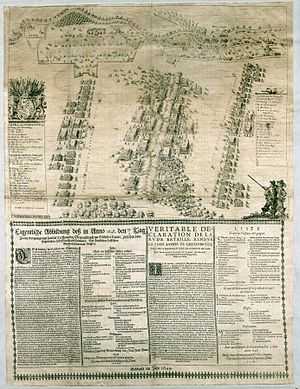Battle of Wevelinghoven
| Battle of Wevelinghoven | |||||||
|---|---|---|---|---|---|---|---|
| Part of Thirty Years' War | |||||||
 | |||||||
| |||||||
| Belligerents | |||||||
| Imperial troops | France, Sweden, Hesse-Cassel | ||||||
| Commanders and leaders | |||||||
| Guillaume de Lamboy | Johann von Geyso | ||||||
| Strength | |||||||
|
7,000 men 11 cannon |
3,600 men 5 cannon | ||||||
The Battle of Wevelinghoven (German: Schlacht bei Wevelinghoven) or Battle of Grevenbroich (Schlacht bei Grevenbroich) was the last battle of the Thirty Years' War. It took place on 14 June 1648 between Imperial and Hessian troops. Several sources cite the Julian date of 4 June.
Background
The Hessians under General Johann von Geyso were stationed in Neuss as an occupying power. To the south, on the territory of the Electorate of Cologne, were Imperial Troops under Field Marshal Guillaume de Lamboy. The Duchy of Jülich-Berg was neutral. As Hessian troops marched towards Grevenbroich, which belonged to Jülich, Duke Wolfgang William feared that an occupation of Grevenbroich by the Hessians would be seen by the Imperial side as an opportunity to declare the neutrality of Jülich-Berg as null and void. He therefore asked von Geyso for an undertaking that Grevenbroich would be spared. As a result, the Hessians did not occupy Grevenbroich and encamped near Wevelinghoven, in order to fall back to Neuss.
The battle
Lamboy advanced with 7,000 men and positioned himself on 13 June in front of the Hessian encampment. However, the Hessians did not engage in battle, but pulled back to a pre-prepared site between Grevenbroich and Wevelinghoven, in order to cross the River Erft there and make for Neuss. The Imperialists pursued them in order to cut off their withdrawal and isolate them from their supply lines. This plan was anticipated by von Geyso, however, and he waited for the Imperial troops in battle formation. Around 5 am on 14 June, the two armies clashed. In spite of outnumbering the Hessians almost 2 to 1, the Imperial Army had to retreat after five hours of fighting. 1,500 of their men were captured and 1,000 lost their lives. Hessian losses were given as 163. Six cannon were also captured.
Aftermath
The defeat of the Imperial Army led Ferdinand III to make further concessions in the peace negotiations that had been running for some time in Münster and Osnabrück. These were finally incorporated into the Peace of Westphalia.
External links
| Wikisource has original text related to this article: |